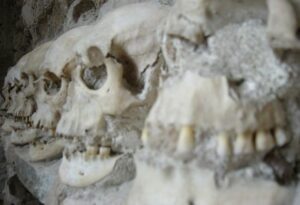PILING UP HEAPS OF SKULLS of your vanquished foes represented the apogee of barbaric warlord behavior.

This ancient practice survived in some cultures well into the historic times. Ćele Kula, (lit. Skull Tower) in Niš Serbia, built in 1809 by Turkish general Hurshi Pasha out of skulls of defeated Serb rebels represents one of the most recent and best preserved examples of this tradition.
The year 1809 marked the turning point in the course of the First Serbian Uprising against the Ottoman Empire (1804-1813). The outnumbered rebel army faced a 36,000 strong force of Turkish imperial guards near the strategically important southern city of Niš. Rather then surrender or flee they decided to put up a desperate last stand at Čegar Hill. Faced with imminent annihilation, the rebel commander Stevan Sinđelić in an act of desperation fired a shot into a gunpowder keg at the fully stocked gun powder room, blowing up his entire army as well as wiping out enemy soldiers who were already flooding the rebel trenches.
Deeply angered by the rebel force’s actions, the Turkish commander Hurshid Pasha decided to teach a grim lesson to the Serbian nation. The bodies of the dead rebels were mutilated. Their skins were pealed off their decapitated heads, stuffed up with straw, and sent to the Imperial court in Istanbul as proof of Turkish victory. The skulls were used as building blocks for a tower built by the main road at the entrance of the city. A warning to the local populace of an impending fate to any potential future rebels.

In total, 952 skulls were used. In its original form, the tower stood 15 feet high and 13 feet wide. Skulls were arranged in 56 rows, with 17 skulls in each row, at each side of the tower. The skull of rebel commander Stevan Sinđelić was placed at the top. This gruesome edifice, left a deep scar in the Serbian national psyche. However, it failed at its purpose. The Serbs rebelled again in 1815, this time successfully, driving off the Turks and winning independence in 1830.

In the years immediately following the building of the tower, the families of deceased rebels chiseled away some of the skulls in order to give them proper funerals. Today 58 skulls in total remain in the tower.
The authorities of Serbia in 1892 built a chapel around the tower to preserve this unique monument representing the nations bravery and sufferings. The skull of Stevan Sinđelić is also on display at the chapel.





